The Heeresgeschichtliches Museum in Vienna is a treasure trove of Austria's military history, housed in a stunning Moorish-Byzantine building. Explore exhibits ranging from medieval weapons to tanks, and see the car that triggered World War I. A must-visit for history and architecture lovers.

Book
Austria by Public Transport
Discover Austria like never before with “Austria by Public Transport.” This book is your ultimate guide to exploring the beauty of Austria easily and affordably. Get your copy today and start your adventure!
The Heeresgeschichtliches Museum is a fascinating place that takes you deep into Austria’s military past. Officially opened in 1891 (unofficially in already 1856), this museum is located in the Vienna Arsenal, specifically in a section called Object XVIII. Most of the Arsenal’s 72 buildings (31 Objects) have survived in their original form, giving visitors a genuine sense of history. The Habsburg government built the Arsenal to showcase its power and prevent uprisings. Today, the site provides a window into Vienna’s rich military heritage.
Gallery
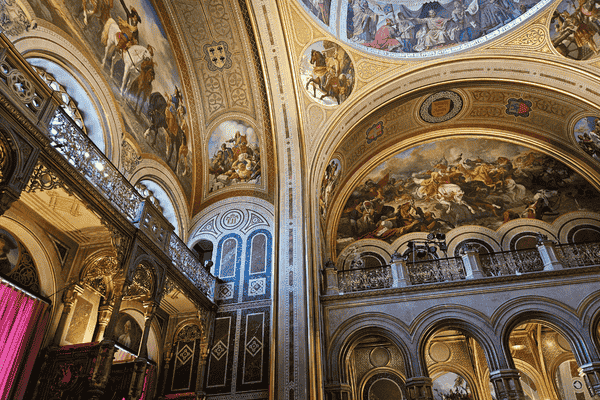
Ornate interior
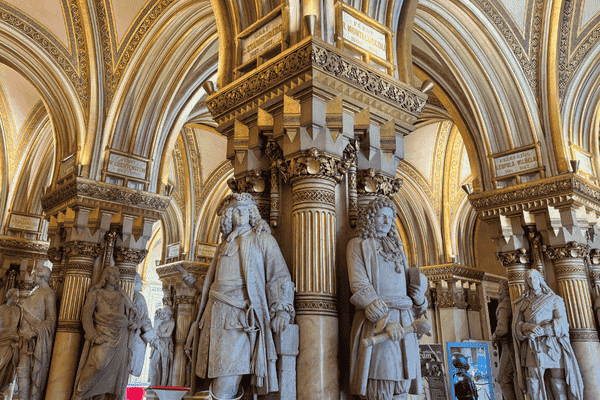
Hall of Heroes
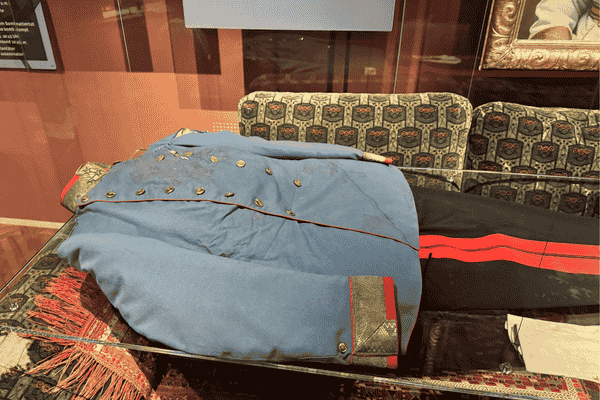
Uniform of Franz Ferdinand

Grand staircase
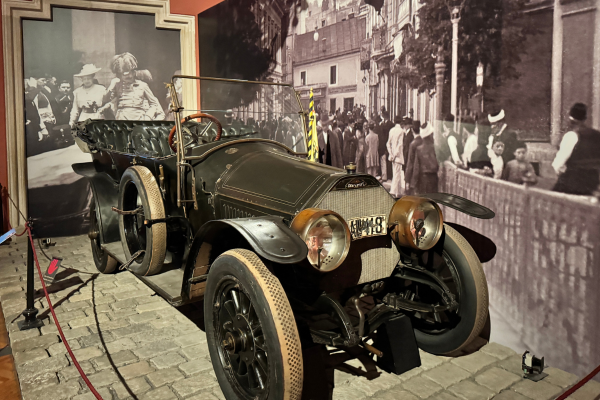
Car of Archduke Franz Ferdinand
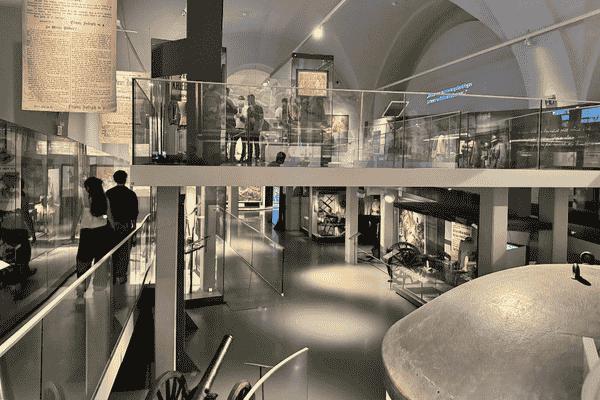
Modern exhibition
A Museum Built with Purpose
The museum opened as Austria’s first purpose-built museum, making it the oldest museum building in the country. Inspired by the 12th-century arsenal in Venice, the architecture reflects a unique Byzantine-Gothic style. The Austrian Hall of Heroes (Feldherrenhalle), a grand reception area, honors Austrian military leaders and welcomes visitors with its impressive design.

Byzantine-Gothic Style
- Domes – Rounded or onion-shaped, often covered in gold or mosaics.
- Horseshoe Arches – Typical Moorish design with intricate patterns.
- Geometric Patterns – Detailed designs and arabesques throughout.
- Colorful Mosaics – Small tiles on walls, domes, and floors.
- Calligraphic Details – Arabic-style inscriptions in the decor.
- Metal and Stone Fittings – Strong, stylish reinforcements on doors and windows.
- Stained Glass Windows – Sunlight creates colorful light effects inside.
- Stucco Work – Detailed carvings on columns, arches, and walls.
- Symmetry – Balanced layout for harmony.
- Columns and Pillars – Grand, decorative columns connected by arches.

Kordian
Hey, it’s me, Kordian! I spend like 10 to 20 hours on each post just for you. This website is my main source of income. If you enjoy using it regularly, I’d totally appreciate your financial support. Your help means a lot and keeps the content coming. Thanks a bunch!
World War II and Rebirth
During World War II, the museum played an unfortunate role by displaying stolen art collected by the Nazis. The building was partly damaged during the war, but many of its treasures were saved beforehand. After the war, the museum was rebuilt and reopened in 1955. Since then, it has been actively working to return stolen items to their rightful owners.
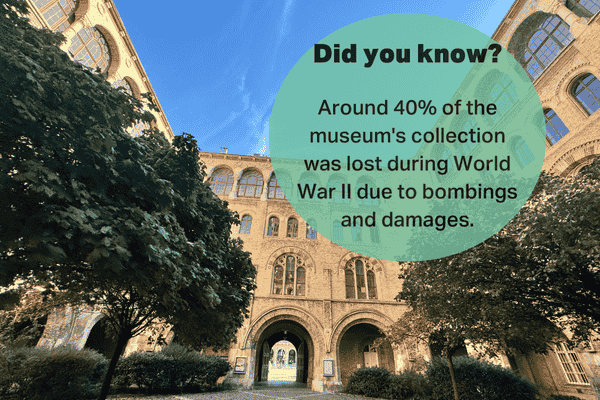
Interesting Facts
- Managed by Ministry – The Austrian Ministry of Defense oversees the Heeresgeschichtliches Museum.
- Location – The Vienna Arsenal, home to the museum, has 72 buildings, though not all are public.
- Naval History – In 1914, Austria had the world’s sixth-largest navy, despite being landlocked today.
- Architect – Theophil von Hansen, who designed this museum, also created Vienna’s Parliament Building, Greek Church of the Holy Trinity, and Musikverein.
- Historicist Architecture – The Vienna Arsenal stands as one of Vienna’s best historicist architectural examples.
- Modern Use – Some Arsenal buildings now serve as apartments, blending history with modern life.
- Sculptures – Made from Carrara marble, the same material used for Michelangelo’s David and the Leaning Tower of Pisa.
- Giant Cannon – The museum houses the Pumhart von Steyr, one of the oldest and largest cannons globally.
- Vast Collection – With over one million items, the museum displays only about 15,000, showcasing Austria’s military heritage.

Subscribe
Explore Vienna like a local and discover nearby treasures.
Join our mailing list!
A Rich Collection of Exhibits
Today, the Heeresgeschichtliches Museum houses a wide array of exhibits, from medieval weapons and historical uniforms to tanks and planes. One of the most famous items on display is the car in which Archduke Franz Ferdinand and his wife Sophie were assassinated in Sarajevo in 1914. This tragic event led to the outbreak of World War I, making the car an important historical artifact that draws many visitors.
Top Highlights
- Car of Archduke Franz Ferdinand – The car in which Archduke Franz Ferdinand was assassinated, sparking World War I.
- Uniform of Archduke Franz Ferdinand – The original uniform worn by Franz Ferdinand at the time of his assassination.
- Napoleon’s Death Mask – An original death mask of Napoleon Bonaparte, one of the most valued relics in the museum.
- Pumhart von Steyr – One of the oldest and largest giant cannons in the world, showcasing medieval firepower.
- Turkish Weapons from the Siege of Vienna – Weapons used by the Ottoman army during the 1683 Siege of Vienna.
- Medieval Armor Collection – The world’s largest collection of Central European medieval armor.
- Cannon from the Battle of Aspern – Original artillery used in the 1809 Battle of Aspern, Austria’s first major victory over Napoleon.
- First Mass-Produced Tank – The first-ever mass-produced tank, showcasing early military engineering.
- Military Flags and Banners – An extensive collection of military flags from the Habsburg monarchy era.
- Models of Austro-Hungarian Warships – Detailed models of warships from the Austro-Hungarian Empire’s naval history.
The museum guides visitors through Austria’s military history, covering periods from the late Middle Ages to the 20th century. Exhibits follow a chronological order, giving a thorough look at the events and shifts that shaped the nation. Visitors can explore weapons, maps, uniforms, and various other artifacts that reveal Austria’s military story.
Ways to Save
- Buy the Lower Austria Card – With this card, you get entry to the Heeresgeschichtliches Museum along with access to 250 other attractions.
- Visit on the First Sunday of the Month – Entry is free on the first Sunday of each month.
- Bring €10 for the Audio Guide – The audio guide is free, but you need to leave a €10 deposit, which is refunded when you return it.
- Bring Coins for Lockers – If you plan to store your belongings, bring some coins to use the lockers.
The Heeresgeschichtliches Museum offers a perfect experience for fans of military history and architecture. The collection inside reveals Austria’s rich past, and the building itself stands as a stunning masterpiece reflecting Vienna’s cultural depth. Whether you enjoy history, weaponry, or beautiful architecture, this museum has something captivating for every visitor.
Join Our Vibrant Community
Are you passionate about discovering the hidden gems of Vienna and its surroundings? Follow us on social media and become part of our enthusiastic community!
Why Follow Us?
- Exclusive Content: Each post is a labor of love, taking between 10-30 hours to create. We share breathtaking photos, captivating stories, and invaluable tips.
- Stay Updated: Never miss out on exciting events, new attractions, and must-visit spots in and around Vienna.
- Support Independent Projects: We are an independent project, and your follows help us cover the costs of running this page. Your support is crucial!
Your Support Matters!
Every follow, like, and share directly supports our work. It helps us continue bringing you the best content and ensures we can keep this site running. By following us, you’re not just staying informed – you’re helping us grow and thrive.
Don’t miss out! Click the links above and start following us today. We can’t wait to connect with you!





